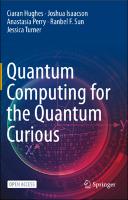Quantum Computing for the Quantum Curious
| dc.contributor.author | Hughes, Ciaran | |
| dc.contributor.author | Isaacson, Joshua | |
| dc.contributor.author | Perry, Anastasia | |
| dc.contributor.author | Sun, Ranbel F. | |
| dc.contributor.author | Turner, Jessica | |
| dc.date.accessioned | 2021-04-20T12:48:03Z | |
| dc.date.available | 2021-04-20T12:48:03Z | |
| dc.date.issued | 2021 | |
| dc.identifier | ONIX_20210420_9783030616014_28 | |
| dc.identifier | OCN: 1244536372 | |
| dc.identifier.uri | https://library.oapen.org/handle/20.500.12657/48236 | |
| dc.description.abstract | This open access book makes quantum computing more accessible than ever before. A fast-growing field at the intersection of physics and computer science, quantum computing promises to have revolutionary capabilities far surpassing “classical” computation. Getting a grip on the science behind the hype can be tough: at its heart lies quantum mechanics, whose enigmatic concepts can be imposing for the novice. This classroom-tested textbook uses simple language, minimal math, and plenty of examples to explain the three key principles behind quantum computers: superposition, quantum measurement, and entanglement. It then goes on to explain how this quantum world opens up a whole new paradigm of computing. The book bridges the gap between popular science articles and advanced textbooks by making key ideas accessible with just high school physics as a prerequisite. Each unit is broken down into sections labelled by difficulty level, allowing the course to be tailored to the student’s experience of math and abstract reasoning. Problem sets and simulation-based labs of various levels reinforce the concepts described in the text and give the reader hands-on experience running quantum programs. This book can thus be used at the high school level after the AP or IB exams, in an extracurricular club, or as an independent project resource to give students a taste of what quantum computing is really about. At the college level, it can be used as a supplementary text to enhance a variety of courses in science and computing, or as a self-study guide for students who want to get ahead. Additionally, readers in business, finance, or industry will find it a quick and useful primer on the science behind computing’s future. | |
| dc.language | English | |
| dc.subject.classification | thema EDItEUR::P Mathematics and Science::PH Physics::PHP Particle and high-energy physics | en_US |
| dc.subject.classification | thema EDItEUR::U Computing and Information Technology::UY Computer science | en_US |
| dc.subject.classification | thema EDItEUR::J Society and Social Sciences::JN Education::JNU Teaching of a specific subject | en_US |
| dc.subject.other | Quantum Physics | * |
| dc.subject.other | Quantum Computing | * |
| dc.subject.other | Computer Science, general | * |
| dc.subject.other | Science Education | * |
| dc.subject.other | Quantum Information Technology, Spintronics | * |
| dc.subject.other | Computer Science | * |
| dc.subject.other | Spintronics | * |
| dc.subject.other | Open Access | * |
| dc.subject.other | Introduction to quantum computing | * |
| dc.subject.other | quantum computing textbook | * |
| dc.subject.other | quantum computing for high school students | * |
| dc.subject.other | introduction to quantum cryptography | * |
| dc.subject.other | quantum gates | * |
| dc.subject.other | quantum algorithms | * |
| dc.subject.other | quantum superposition | * |
| dc.subject.other | what is a qubit? | * |
| dc.subject.other | quantum key distribution | * |
| dc.subject.other | Quantum physics (quantum mechanics & quantum field theory) | * |
| dc.subject.other | Mathematical theory of computation | * |
| dc.subject.other | Teaching of a specific subject | * |
| dc.subject.other | Science: general issues | * |
| dc.subject.other | Textbook | * |
| dc.title | Quantum Computing for the Quantum Curious | |
| dc.type | book | |
| oapen.identifier.doi | 10.1007/978-3-030-61601-4 | |
| oapen.relation.isPublishedBy | 6c6992af-b843-4f46-859c-f6e9998e40d5 | |
| oapen.relation.isFundedBy | d2e5ab0a-324d-4d9b-91cc-c897c1d5bde5 | |
| oapen.relation.isbn | 9783030616014 | |
| oapen.imprint | Springer | |
| oapen.pages | 150 | |
| oapen.grant.number | [grantnumber unknown] |

